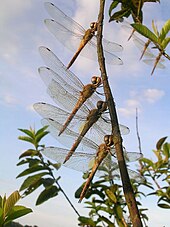Pantala flavescens
[4] It is considered to be the most widespread dragonfly on the planet, with good population on every continent except Antarctica, although rare in Europe.
The males have golden yellow patch on base of hindwings and narrow apical brown spot at the hind border of wings.
[8][9] In mainland males, the length of the femur, the longest leg section, varies; they also have longer front and shorter hindwings than the females.
The unpaired dorsal plate of the eleventh segment, called the epiproct, is roughly the same length as or longer than the paraproct.
[13] Pantala flavescens may be confused with the P. hymenaea, the "spot-winged glider", but this has a striking brown basal fleck in the hindwing and is generally slightly darker in colour.
Those on Easter Island have adapted away from their migratory habits because to fly out to the open sea would usually mean certain death.
[22][23] In Europe there are only occasional sightings of the species, with credible evidence to date mainly from the Aegean Sea and the adjacent mainland.
Globe skimmer records from England or France are doubtful and may arise from co-importation with shipments of bananas.
An explanation for the scarcity in Europe of this otherwise common species is the barrier effect of the Sahara which generates unfavourable winds, such as the Sirocco,[21] whose dryness makes dragonfly passage almost impossible.
[25] More evidence of their preference for moist winds is that the dragonfly migrates to Southeast India's Tamil Nadu only after the second monsoon, which brings the rain to that region.
The winds during the migration from India to mainland Africa are not as strong as the Somali jet, and thus there are multiple stopovers en route at the Maldives, Seychelles, and Mozambique.
These individuals seem to be a small gene pool, derived from the continental populations, which is slowly creating a new type by genetic drift.
The species cannot overwinter in colder areas like South Australia and Southern Canada, and must therefore be resupplied there by new migrants each year.
[10] According to recent research carried out by biologists at Rutgers University-Newark this species of dragonfly is the world's longest known distance insect traveller.
Genetic evidence taken from dragonflies across the globe suggests that these small size insects are travelling vast distances to mate and are thus creating a worldwide gene pool.
[30] Modelling of dragonfly flight, energy reserves and wind speeds in the Indian Ocean have suggested that Pantala flavescens performs the longest known non-stop migration compared to body size in the animal kingdom.
Specifically the theorised migratory route from Male, Maldives to Kap Hafun, Somalia, is >2500 km long and constitutes travelling 50.7 million body lengths of the dragonfly without any possibility of stopping to rest.
[31] The English common names "wandering glider" and "globe skimmer" refer to its migratory behaviour.
Alae albae stigmate marginali niveo.The first description of this underlying holotype is in the Zoological Museum of Copenhagen University taken from a female collected from India.
Around 1823 the British entomologist Dale, in an unpublished manuscript, described an allegedly Norfolk-trapped male as Libellula sparing halli,[32] It is now in the Oxford University Museum of Natural History.
A description made of Sympetrum tandicola (Singh) 1955 from a male collected in the Himalayas and deposited at the Zoological Survey India, Calcutta, was identified as belonging to Pantala flavescens in 1973.
[4] The globe skimmer has NatureServe conservation status G5, meaning it is secure (common, widespread and abundant) worldwide.
On 29 July 1974 Wallis and Futuna published a 45 franc with a dragonfly over a water surface with some plants showing.
[37] Wallis and Futuna published another stamp on 4 August 1998, a 36F with the dragonfly shown flying on a yellowish background.




